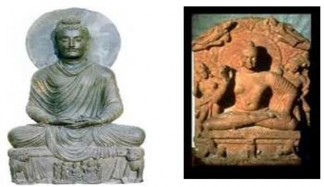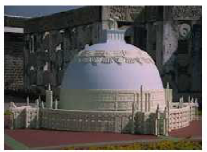5.3 Sculpture
The apex of the sculpture making is said to be found in this period. The first century CE onwards, Gandhara (now in Pakistan), Mathura in northern India and Vengi in Andhra Pradesh emerged as important centres of art production. Buddha in the symbolic form got a human form in Mathura and Gandhara. The sculptural tradition in Gandhara had the confluence of Bactria, Parthia and the local Gandhara Tradition. The Gandhara region had long been a crossroads of cultuaral influences. During the reign of Emperor Ashoka, the region became the scene of intensive Buddhist missionary activity. And in the 1st century CE, rulers of Kushan empire which included Gandhara, maintained contacts with Rome. In its interpretation of Buddhist legends, the Gandhara school incorporated many motifs and techniques from classical Roman Art. On the other hand, the local sculptural tradition at Mathura became so strong that the tradition spread to other parts of northern India.


Gandhara Mathura Amravati
Images of Vaishnava (mainly Vishnu and his various forms) and Shaiva (mainly the lingas and
mukhalingas ) faith are also found at Mathura but Buddhist images are found in large numbers.
Basis | Gandhara | Mathura | Vengi (Amravati) |
Influence | Greek or Hellenistic influence also called Indo-Greek | No outside influence; Indigenous | Indigenous |
Types of Sandstone | Grey/Bluish grey sandstone | Spotted red sandstone | White marbles |
Religious influence | Mainly Buddhist | All 3 religions – Jainism, Buddhism, Hinduism | Mainly Buddhist |
Patronized by | Kushana dynasty | Kushana Dynasty | Satavahans and Icchavakus |
Areas | North West frontier | Mathura, Sonkh, Kankalitila (Mostly Jaina) | Krishna-Godavari lower valley |
Features of Sculptures | ♤ Spiritual Buddha (Sad Buddha) represents calmness, Bearded, Moustache | ♤ Delighted Buddha i.e. not spiritual ♤ head and face Shaven ♤ dress is tight; energetic body ♤ face reflects grace | ♤ Reflects narratives theme based on life of Buddha and Jataka stories. ♤ Stories of |
♤ wearing less ornaments ♤ wavy hair (Greek) ♤ large forehead (Greek) ♤ Buddha is seated in position of yogi ♤ Having large ears (Greek) ♤ Eyes half closed ♤ Protuberance on his head (signifies that Buddha knows all) | ♤ seated in Padmasana. ♤ Right hand in AbhayMudra (Indicate reassurance) raised above shoulder, Left hand on left thigh (reflect muscularity). ♤ Protuberance on head. | previous births of Buddha - both in human as well as animal form. ♤ Sculptural composition is more complex and characterized by intense emotions, bodies are shown with three bents (i.e. tribhanga) |

Gandhara:
Two Schools
Early
Later
Use of Bluish
grey sandstone
Use of Mud and Stucco
(lime plaster)
